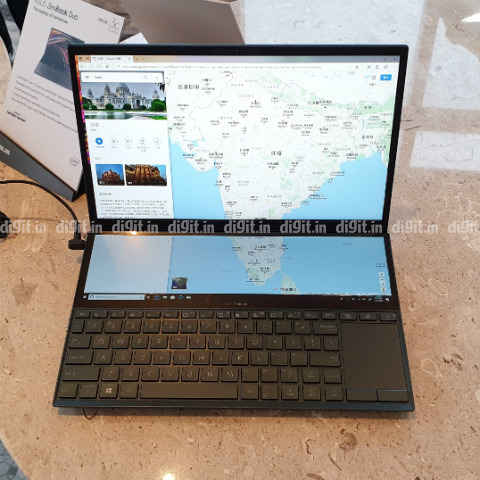Asus ZenBook Duo, Pro Duo First Impressions: More of the same
Here are some first thoughts on Asus' new ZenBook Duo and ZenBook Pro Duo laptops.
Both feature Asus' ScreenPad Plus innovation.

Before I get into what the ZenBook Duo and ZenBook Pro Duo are like, here’s a bit of backstory. A couple of days before Computex 2019, Asus invited me and a large company of journalists from India for a sneak peek at its new product launches for this year. As we made our way to Hotel Amba in Taipei in a private double-decker bus that Asus had hired for us, I heard some relevant questions going around. Curious, I listened on.
 Survey
Survey“Do you think Asus will show yet another laptop with a ScreenPad this time around?” said a journalist, referring—of course—to the ZenBook Pro 15 from last year. You'll remember that it was the first to come with Asus’ ScreenPad innovation. In other words, it had a touchscreen display within the touchpad for extra viewing space and added functionality. “We should ask if Asus has added any new features to it,” said another. I for one believed it was the end of that little project.
What Asus had in mind for the ScreenPad became clear to all of us right after the presentation. It turns out that Asus not only incorporated a “ScreenPad 2.0” in its ZenBook and VivoBook series, but it also created a larger version of it called ScreenPad Plus for two flagship ZenBook models. It’s clear that Asus is betting big on this new innovation. It’s safe to say that if having a touchscreen display in the touchpad is what boosts productivity in everyday computing, Asus has the early lead.
ScreenPad Plus: The original ScreenPad has grown up
While the ZenBook Duo is a 14-inch model, the ZenBook Pro Duo is a 15.6-inch model. Both laptops essentially have a regular display on the top fold (as you’d see on any other laptop, really) but the bottom half is where you see the twist. There’s an ultra-wide display in the place of the keyboard and it spans the entire width of the base panel. Below that wide display is where you find the keyboard, and to its right is the touchpad, mounted in portrait orientation.
Both models come with Intel 9th Gen Core series CPUs and NVIDIA-powered graphics. More specifically, the ZenBook Duo is powered by an Intel 9th Gen Core i7 CPU and an NVIDIA GeForce MX250 graphics card. The primary display on it is a 14-inch Full HD unit, while the ScreenPad Plus is an ultra-wide 12.6-inch touchscreen display with Full HD resolution. The ZenBook Pro Duo, on the other hand, is powered by an Intel 9th Gen Core i9 CPU and an NVIDIA GeForce RTX 2060 graphics card with 6GB of video RAM. The primary display on it is a 15.6-inch 4K touchscreen unit, while the ScreenPad Plus is an ultra-wide 14-inch touchscreen display with 4K resolution.
While the ZenBook Duo supports a maximum of 16GB of RAM, the larger (and imaginably more expensive) ZenBook Pro Duo supports a maximum of 32GB of RAM. Both models come with up to 1TB of internal storage space courtesy of four PCIe NVMe solid-state drives. According to Asus, the ScreenPad Plus on both models comes with suitable proprietary software to boost productivity and help snap fit windows into place. Apart from providing access to common utilities, the bundled ScreenXpert tool helps users place up to three windows in a row on the ScreenPad Plus. This should minimise distractions caused by small windows, like Spotify or WhatsApp for PC. The ZenBook Pro Duo even comes with a bundled active stylus.
First Impressions: A bit glitchy
At first glance, the ZenBook Pro Duo looked like an ROG Zephyrus model whose Republic of Gamers logo had been replaced with a wide display. In reality, it was more than that. The sides of the laptop had a distinct silvery finish and the exhaust vents looked uncharacteristically sharper. While the ZenBook Pro Duo was great to look at, it was difficult to handle it. Because its keyboard sat at the very edge there was no place to grip the base panel without hitting a key or two. It was the same case with the smaller ZenBook Duo. The only consolation was that the ZenBook Duo was noticeably lighter.
Recognised by Windows 10 as a second display, the ScreenPad Plus seemed a bit glitchy during operation. While it felt comfortable showing a couple of windows side by side, getting it to do that was a chore. Windows had to be dragged manually to the ScreenPad Plus, and that did not always happen as anticipated. Windows would sometimes be maximised in the primary display or not sit in one side properly. Hitting the dedicated ScreenPad Plus enable/disable button would often cause Windows 10 to freeze completely.
Typing with the device on the lap seemed like the biggest challenge with the ZenBook Duo and ZenBook Pro Duo. Because the ScreenPad Plus ate up the space that’s typically reserved for the keyboard and touchpad, there was a shortage of space on the laptop’s base panel. Asus therefore had no choice but to axe the palm rest and offer it as a detachable accessory along with the ZenBook Pro Duo. The workaround may be effective when the laptop is placed on a table but not when it’s placed on the lap. Though it’s still too early to tell, the new ScreenPad Plus didn’t seem to offer much in its newest avatar on the ZenBook Duo and ZenBook Pro Duo except for more screen space. Let’s find out if that’s true when Asus starts selling the two ZenBook models later this year in the third quarter.
Vignesh Giridharan
Progressively identifies more with the term ‘legacy device’ as time marches on. View Full Profile